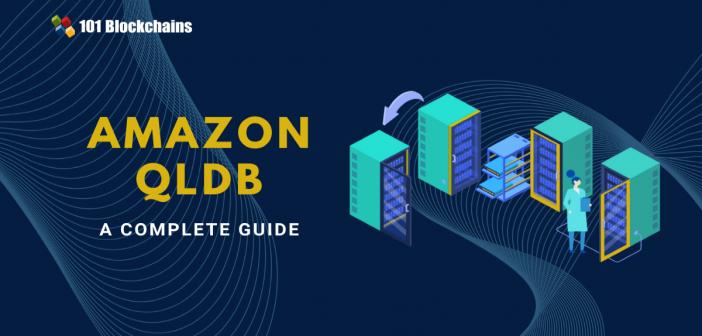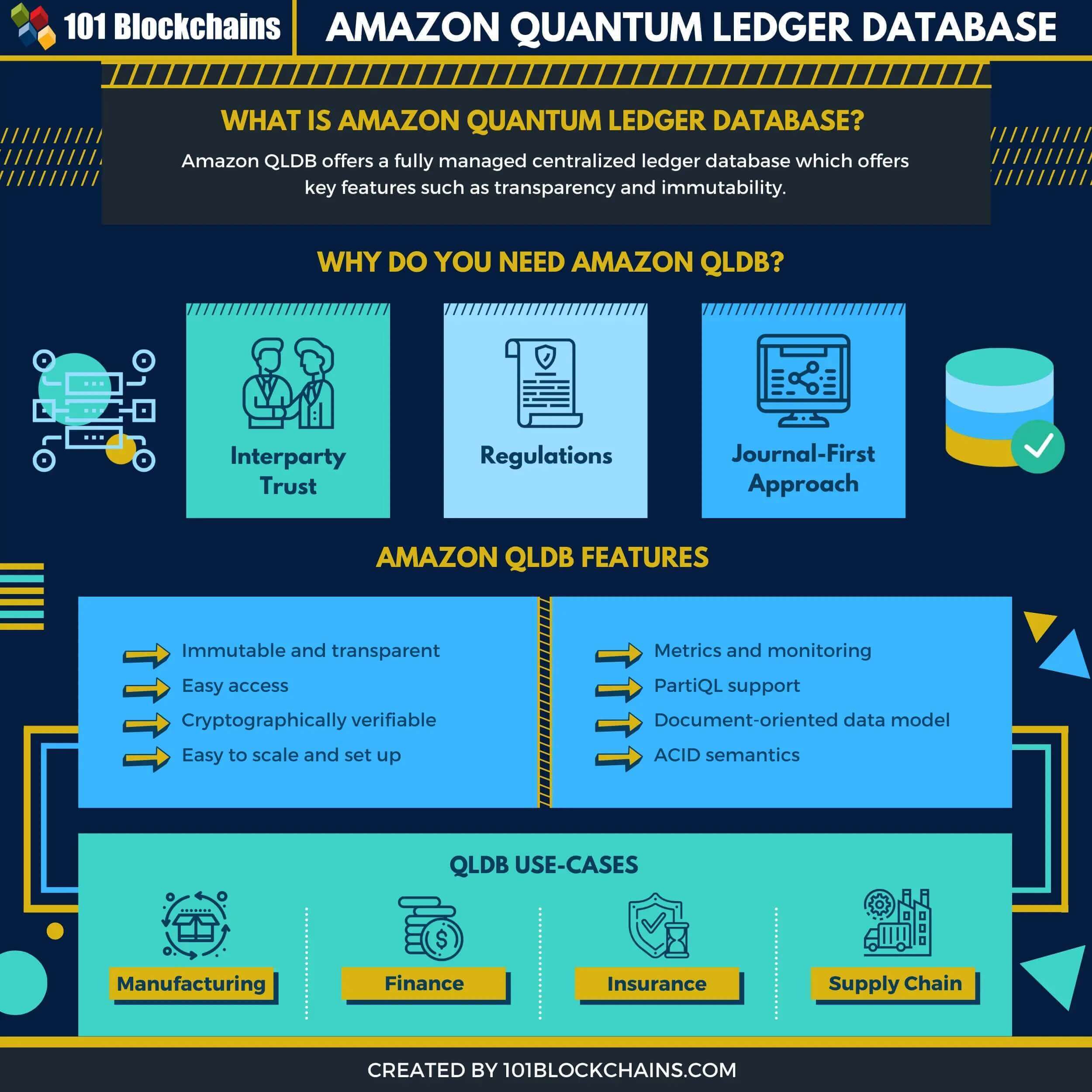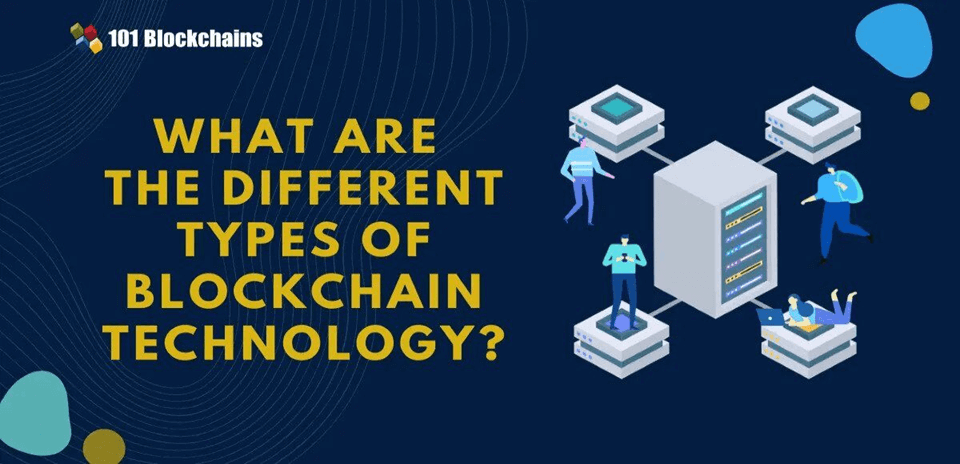Learn how blockchain truly works, master key definitions, and uncover what makes smart contracts so "smart." Dive into the fundamentals, gain valuable insights, and start your blockchain journey today!

- Reviews
101 Blockchains
- on April 12, 2021
A Complete Guide On Amazon QLDB
This article offers a detailed view of Amazon’s Amazon Quantum Ledger Database or QLDB, in short. Also, you’ll find the features, functionality, and use cases of QLDB.
Do you want to learn about Amazon QLDB? If you do, then you have come to the right place. In this article, we will explore the Amazon Quantum Ledger Database (QLDB).
Amazon is always at the front when it comes to blockchain technology or any technology in general. Amazon, itself being a giant knows the importance of data among businesses. It is important for businesses to ensure proper data management.
Blockchain has shown the potential to change every sector out there. Also, blockchain is equally useful when it comes to storing data. After all, it is a distributed ledger. Also, the fact that traditional databases will soon make its way out for the more robust blockchain-based database. However, businesses just cannot use a decentralized database for their business as they have to protect their private data.
This is where AWS QLDB comes in. Let’s explore it in more detail below.
Enroll Now: Certified Enterprise Blockchain Professional (CEBP)
What is Amazon Quantum Ledger Database?
Amazon QLDB offers a fully managed ledger database. It offers all the key features of a blockchain ledger database including immutability, transparency and cryptographically verifiable transaction log. However, QLDB cis owned by a central trusted authority. So, in a sense, it has almost all the features of a distributed ledger technology with a centralized approach.
Also, you can’t compare Amazon QLDB vs blockchain as the two have some fundamental differences. QLDB is launched along with Amazon Managed Blockchain.

Please include attribution to 101blockchains.com with this graphic. <a href='https://101blockchains.com/blockchain-infographics/'> <img src='https://101blockchains.com/wp-content/uploads/2021/04/Amazon-Quantum-Ledger-Database-AWS-QLDB-1-1.jpg' alt='Amazon Quantum Ledger Database AWS QLDB='0' /> </a>
Read More: QLDB vs Hyperledger— A Better Amazon QLDB Alternative?
What’s the Need for A Centralized Ledger-Based Database?
If you are an enterprise user, then you should know how data is stored. Until blockchain became a viable option, the data is stored in a centralized database. With blockchain, there are multiple ways, blockchain technology can be used in two ways.
The first way is to make proper use of a centralized ledger that lets you log all the transactions and logs. This approach is widely used in the supply chains, insurance, or credit industry where it is important to track every possible change in the system. In this model, a centralized authority has ownership of the centralized ledger which is shared among the companies.
The second way is to utilize a ledger technology or relational database using open-source blockchain frameworks.
If you take both of the approaches, none of them are optimal for the current challenges of the industry. The fact that the relational database cannot work with cryptography is a big drawback. For relational databases, customers are required to create custom audit trials and tables.
A centralized ledger-based database powered by blockchain is the answer to all of these. The users can opt to create a ledger where all the changes of the data are stored and are immutable in nature. This means that not only the data is stored, but also its history is stored to provide the necessary means to verify data. The data also needs to be cryptographically handled for it to be immutable.
A Fully-Fledged Ledger-Powered Blockchain Database
All of these requirements are met by Amazon QLDB where it provides a way to properly configure and deploy a ledger-powered blockchain database. With it, organizations can be in control of the data that is being stored and distributed.
They can track the data changes and see if it is verifiable. If an organization is using old methods, they need to create custom audit tables or trials. It is not efficient and is not 100% full-proof.
Moreover, creating and maintaining custom audit tables and trails require custom development which means investing more time and money into it. Moreover, custom development is also prone to human errors.
But what if companies or organizations try to utilize blockchain solutions such as Ethereum and Hyperledger Fabric to create and manage ledger?
It can be done; however, it can also lead to implementing a complete blockchain solution which will increase the complexity of the whole project.
Enroll Now: Enterprise Blockchains Fundamentals Course
Why Do We Need Amazon QLDB?
Alright, we learned a lot about the Amazon QLDB, but we still need to establish its need in the current ecosystem of solutions and technologies. In this section, we will go through the points that reinforce the need for Amazon QLDB. Let’s discuss the points below.
Interparty Trust
There has been unparalleled growth when it comes to the industries. In the last decade or so, companies are now ready to take on new technologies that solve core problems such as trust.
Right now, companies generate tons of data through their different processes. It can be related to the supply chain or retail outlets or in fact the manufacturing process, it is important for them to have data that is verifiable and trustable.
This gives rise to the need for a ledger-based database that provides key features such as verifiable ledger, immutability, and cryptography so that every single change in the database can be tracked and improved upon.
All of these mean a better interplay of trust among the players in the business world. The end-users, i.e., customers can also expect amazing transparency when it comes to seeing the history of a transaction unfold in front of them.
For instance, customers can check how the insurance company is managing the insurance behind doors and customers can ensure that no manipulation has been done.
Another good example is real estate transactions where no one can sell properties by fraud as the history of the real estate property contains all the valuable information about its ownership.
However, blockchain is already capable of performing these tasks. If you go through the blockchain for insurance and blockchain for real estate articles, you can have a better idea.
Regulations
Compliance is another pain-point for the organizations out there. This compliance varies depending on industry to industry. However, there is one common thing between them, i.e., audit trails. These audit trails need to be thoroughly maintained by organizations for an extended period of time.
Another challenge is to make sure that all the actions are well documented and stored in the trial. In short, the audit trails are a history book of every move and action made by the organizations.
The challenge, however, is to use the traditional database as a way to overcome the audit trail problems. For that, organizations not only need to ensure their proper traditional database but also make sure that there are audit trails for internal audits. Doing so can be a daunting task where companies need to create complex solutions that are also not full-proof.
The solution is to Amazon QLDB which creates an auditable, verifiable, and immutable database.
Enroll Now: Getting Started with AWS Blockchain as a Service (BaaS)
Journal-First Approach
Journals are an old way to record events. After all, the end result is to have derivative information of all the transactions. Amazon QLDB also takes a journal-first approach which we will discuss later on.
The approach is very useful as it keeps a historical copy of the data. The users are most benefited from the approach.
Amazon QLDB Benefits/Features
Amazon QLDB comes with a number of features and benefits. Let’s discuss them below one by one.
Immutable and Transparent
The first thing that you will notice about QLDB is its immutability. It is possible because of the use of the append-only journal. The journal stores a sequenced and accurate entry of every data change that takes place within the system.
Also, the Journal is append-only which means it is immutable in nature and has the capacity to store the history of any transaction or data change. This also means that any data that is stored cannot be modified or changed.
If there is a need to remove some data from a database, then the ledger will keep the knowledge of the deletion with its previous value and states.
Easy Access
Amazon QLDB knows that it is important for the data to be accessible easily for the user. That’s why the application lets you check the entire history with ease. To check, the user needs to use the querying language. He can check both the historical changes and as well as the transaction history.
Cryptographically Verifiable
Each of the changes is verifiable through cryptographic hashes that are connected to each change of data. It creates a concise summary of all the changes that you made to the data. It is known as a digest or secure summary. To make sure that it is not easily hackable, it utilizes the SHA-256 cryptographic hashing.
So, if you take data, and make changes to it, then a digest will be created that is used as a proof of the change. It can be used to check the integrity and verifiability of the data. Also, the digest can be accessed using QLDB’s API.
Moreover, you can also use the QLDB to know the data’s history and make the most out of the querying interface that it has to offer.
Easy to Scale
Amazon QLDB is easy to scale. It offers the option of automatic scaling which is seamless in nature. This means that there is no need to do manual work to scale your application. Moreover, if you are using an enterprise blockchain framework, QLDB will also work with it — improving its performance.
QLDB is way faster compared to traditional blockchain framework data transfers as it lets you do transactions 2-3x faster.
Any traditional blockchain solution needs to work with its nodes to validate the transactions. But, in the case of Amazon QLDB, it is not a requirement.
Also Read: What Is Blockchain On AWS?
Easy to Set Up
You can easily set up Amazon QLDB as it doesn’t require any servers for provision capacity and management. Within minutes, you can create a new ledger available in the AWS Command Line Interface (CLI), AWS Management Console, or other methods.
Metrics and Monitoring
With Monitoring and Metrics, you can manage and have a proper operational view of your solution.
PartiQL Support
QLDB comes with the support of PartiQL. It is a standard query language with the support of SQL-compatible access to the QLDB. With it, the user can connect with the document-oriented data model. This means that PartiQL can be used irrespective of the underlying data source. In terms of usability, PartiQL is easy-to-use and offers a good set of SQL operations that will feel familiar.
Document-oriented Data Model
The Document-oriented Data Model is supported by the Amazon QLDB. It enables users to use flexible data storage and offers a well-structured data model.
ACID Semantics and Transactional Consistency
QLDB comes with the support of ACID property. The ACID property stands for atomicity, consistency, isolation, and durability. Other key database features include full serialization.
How Does QLDB Work?
There are two key components of QLDB that we need to know how it works.
- Journal: A journal is at the core of QLDB. It is an immutable transaction log. Any transactions that are stored in the Journal are appended as blocks of data. These blocks are connected with a hash of data for verifiability using cryptography. Once data is stored here, it cannot be changed or deleted.
- Current state and history: To ensure that data is well-maintained in the Journal, it maintains two more tables known as the current table and history table. The current table contains the latest state of the data, whereas the history table includes the history of the data.
Amazon QLDB Use-Cases
In this section, we will take a look at the Amazon QLDB use-cases. The Amazon QLDB use-cases are important to get a complete glimpse of what QLDB has to offer.
Manufacturing
The manufacturing companies can take full advantage of what QLDB Amazon has to offer. In manufacturing, it is important for companies to make sure that their supply chain data matches that of the supply chain. With QLDB, they can record every transaction and its history. As we’re already seeing blockchain in manufacturing, QLDB will only make things more efficient.
This means that each of their individual batches will be properly documented. In the end, they will be equipped with the knowledge of tracing the parts if something goes wrong during the distribution life cycle of a product.
Finance
The blockchain in trade finance sector can benefit immensely using a Journal-first approach. By using a solution that is powered by QLDB, they can track critical data including bank accounts transactions, loans and so on!
The finance organizations also do not need to invest in creating a custom-based solution.
Enroll Now: Enterprise Blockchains and Trade Finance Course
Insurance
The blockchain for insurance sector can work efficiently and effectively with the Amazon QLDB. With it, they can have a proper history of the transactions and can result in better claims. As of now, Insurance companies use their complex auditing solutions that use old technologies such as relational databases.
If they use the QLDB, they can keep the whole historical data about a transaction and solve any potential conflict that mainly arises in the insurance sector. The cryptographically secure ledger also makes sure that no data is compromised or manipulated.
Retail & Supply Chain
With QLDB Amazon, retailers can take proper care of their supply chain and access information about a product on their retail outlets and as well as supply chain.
As you can see, QLDB can help two sectors at once —
For instance, they can know when the items are shipped, when they will reach the retail, and who is handling the shipment. All these details are very beneficial and help retail to always keep stock updated and ready to go. Their logistics also improve with better transactional and historical data.
Enroll Now: Enterprise Blockchains and Supply Chain Management Course
QLDB Customers and Partners
At the time of writing, QLDB has made strong partners and has also acquired customers. Some of them include the following.
- Digital Asset
- Accenture
- Asano
- Realm
- Wipro
- Zillant
- Splunk
- Klarna
Amazon QLDB FAQ’s
By now, you should have a good understanding of what Amazon QLDB has to offer. But there can be some confusion that may still cloud you. That’s why let’s go through some of the FAQ questions that we think will help you understand QLDB Amazon better.
Q: What data can be stored in a ledger database?
A: Generally, system-of-record applications can benefit most with QLDB as it offers verifiability, completeness and data integrity. For example, logistic space and supply chain can benefit most from it.
Q: Is Amazon QLDB blockchain service or distributed ledger?
A: Amazon QLDB doesn’t fall under either of these. It is a database-type that takes the best bits from distributed ledger solutions and utilizes it for the best benefits of the companies.
Q: How to connect applications to Amazon QLDB?
A: You need to install an AWS-provided QLDB driver.
Q: How much faster Amazon QLDB is compared to traditional blockchain frameworks?
A: It is generally 2-3x times faster.
Q: What is PartiQL?
A: PartiQL is an open querying language used to manipulate and access data to QLDB.
Q: How can you backup the ledger?
A: Ledger snapshot can be taken anytime to back it up. It is also easily restorable.
Conclusion
This leads us to the end of our Amazon Quantum Ledger Database (QLDB) guide. It offers a cryptographically verifiable history with complete satisfaction of the company and the users. It also has excellent use-cases including supply chain, finance, retail, and so on. Amazon QLDB pricing seems quite affordable. For example, If your application has 180 IO requests per second and 0.15 write IO requests with application data of 30 GB Journal and 30 GB Index storage, you only need to pay $73.06 per month.
So, what do you think about the Amazon QLDB? Are you going to use it in your project?
If you want to have a better grasp of the fundamentals of blockchain, you should enroll in our free blockchain course!




